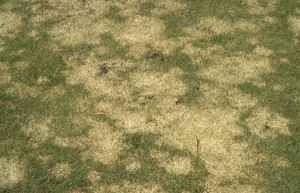Snow Mold
 There are typically two kinds of snow mold: Gray snow mold and pink snow mold. This disease is usually noticed first as the snow melts in the spring. It is commonly found in those turf areas of greatest snow accumulation, such as along driveways or over the brink of a hill where snow drifts tend to accumulate.The most notable symptoms are white crusted areas of grass in which blades are dead, bleached, and matted together. These bleached areas can range from several inches to several feet across. Snow mold has pinhead-sized fungus bodies called sclerotia. These light to dark brown sclerotia are embedded in the leaves and crowns of the infected grass plants.
There are typically two kinds of snow mold: Gray snow mold and pink snow mold. This disease is usually noticed first as the snow melts in the spring. It is commonly found in those turf areas of greatest snow accumulation, such as along driveways or over the brink of a hill where snow drifts tend to accumulate.The most notable symptoms are white crusted areas of grass in which blades are dead, bleached, and matted together. These bleached areas can range from several inches to several feet across. Snow mold has pinhead-sized fungus bodies called sclerotia. These light to dark brown sclerotia are embedded in the leaves and crowns of the infected grass plants.
Recovery can be jump started by raking the matted turfgrass, which facilitates air movement within the turf canopy.

To prevent Snow Mold next year, you need to think about it this year. Late this fall, mow your grass as low as you dare cut it, the lower the better. We have a preventative fungicide that can be applied late in the fall before the first snowfall. Upgrading your fertilizer program to our all organic Nature Safe® fertilizer will also introduce soil microbes that break down the spores of the disease that cause snow mold.
